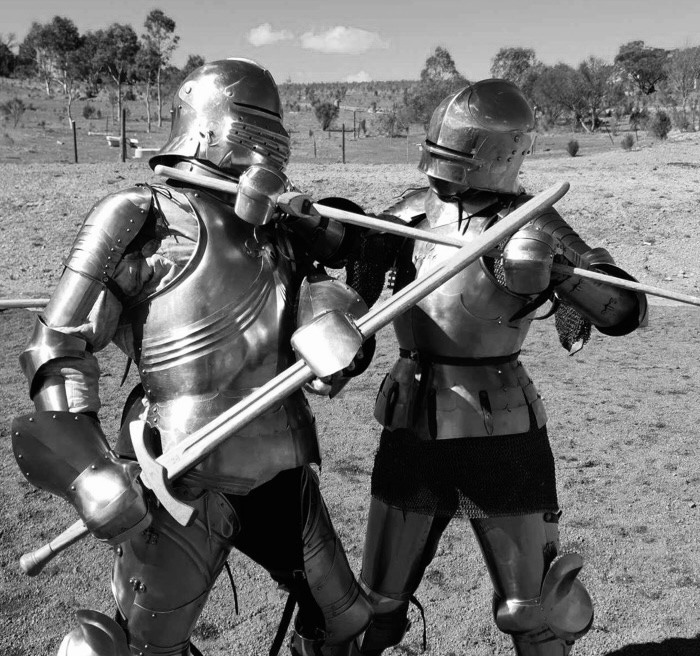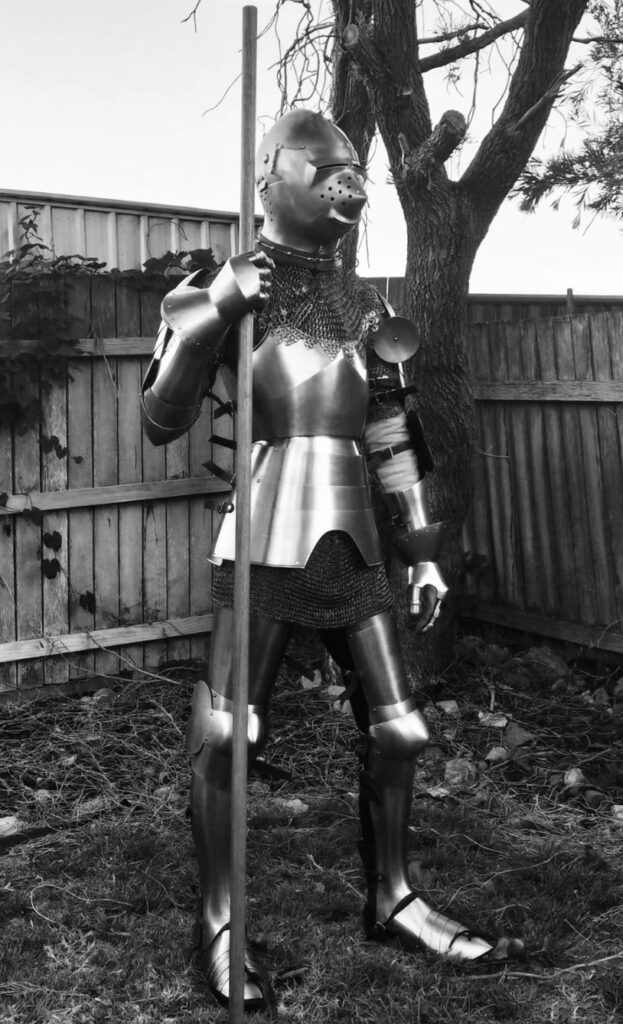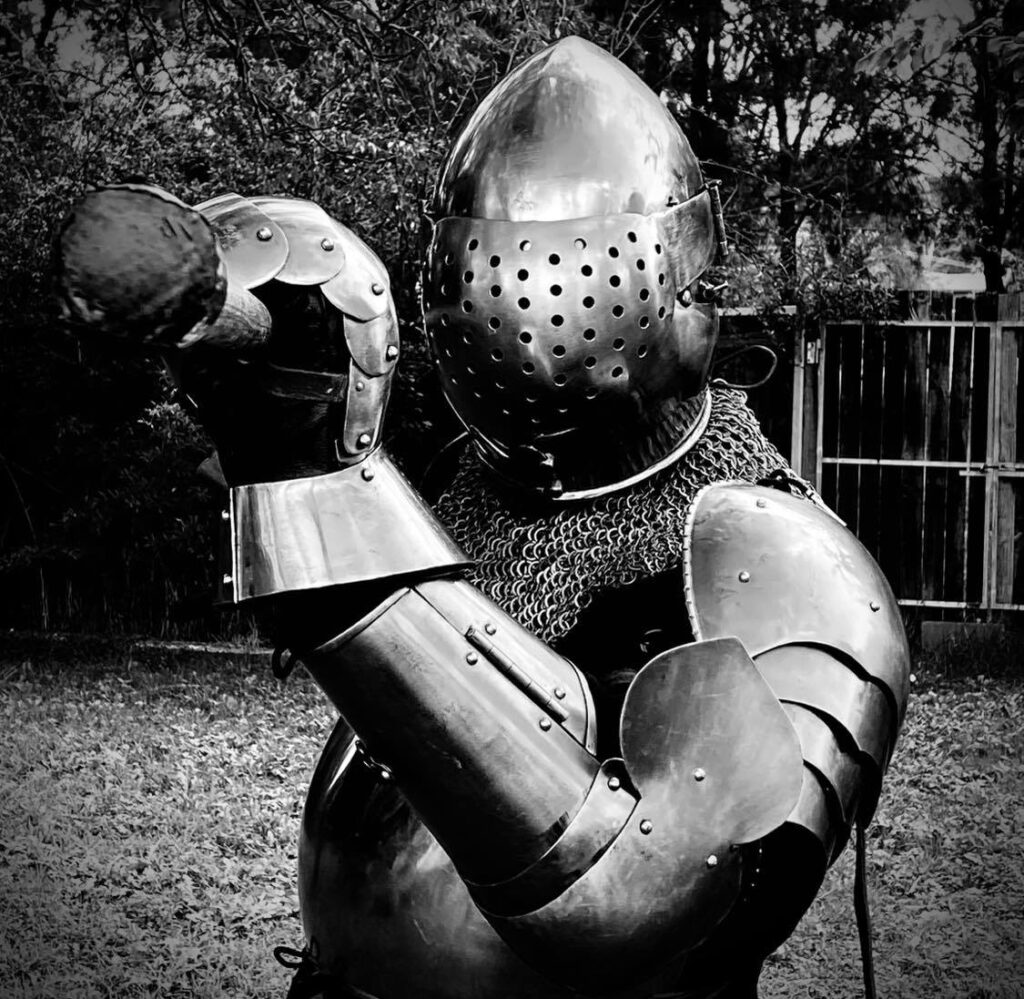Introduction:
Harnischfecten, “armoured fighting” is the set of techniques built around combat in armour. By the 14th Century, the design of armour was improving, with plate becoming more prevalent. Previously staple weapons like spears and swords were increasingly ineffective against these newer forms of armour. The additional protection also meant knights and men-at-arms had less need for shields and could utilise the reach and power of two handed weapons without fear. These two factors spurred technological and tactical development, leading to the weapons and techniques we use in harnischfecten. Historically, harnischfecten techniques were taught both for judicial duels and for the purpose of warfare.
The curriculum:
The experience of fighting in armour is unlike any other martial art. Simply wearing armour is a skill as it restricts mobility, vision, and breathing while affecting your balance and weighing you down. Mastering armoured fighting is challenging, but nothing can bring you closer to the experience of what it was like to be a knight of the Middle Ages.
Our harnischfecten curriculum includes three weapons: the poleaxe, the spear, and the longsword wielded in a special way to counter armour called ‘half-swording’. Harnischfecten fights also make frequent use of ringen “wrestling” but that is normally taught as part of the blossfecten “unarmoured fighting” curriculum.
The poleaxe was the premier anti-armour weapon of the late Middle Ages. There is no exact definition of a poleaxe as, like with many other weapons and armour types, there were numerous variations throughout the years. Generally speaking, a poleaxe is a 1.5-2 metre long polearm with a head consisting of some combination of hammer, axe head, and/or spike with a spear-like tip on both ends, making it an incredibly versatile weapon. Our texts use a hammer/spike combination. Historically, the hammer was used to disorientate and concuss an opponent through striking and could sometimes bend armour plates. While this would sometimes end a fight, more commonly fights were ended by a thrust to a gap in the armour. The spike is not used for striking but instead as a hook for grappling, good for catching behind the knees or neck.
Spears were going out of fashion in the time the German school was being codified, but spears could always be found on the battlefield owing to the simplicity of their design and their relative ease of use. Spears were primarily used as a thrusting weapon, ending fights by finding a weak point in your opponent’s armour (trying to do this in a duel is an excellent demonstration of why spears went out of fashion), but the shaft of a spear could also be used to push, trip, or pull an opponent.
Longswords were not made for fighting against opponents in armour, cuts will bounce right off and it’s hard to wield it with enough precision to find a gap to stab. For this reason, half-swording was developed to give you a fighting chance to defeat an armoured opponent. In half-swording, you grip the blade of the sword (wearing gloves) and use it almost like a miniature spear, giving you better leverage and control and allowing you to use your sword as a grappling aid. A longsword could also be gripped like a hammer, holding the blade, and the crossguard used to strike in what was called mordstreich, “murder strike”. Armoured longsword fighting is claustrophobic, fast-paced, and brutal.
Equipment
The harnischfecten weapons we use are designed to emulate historical weapons with the best balance of safety, accuracy, and cost we can get. We use poleaxes and spears made with a rattan shaft; the poleaxes have hard rubber heads while both the poleaxes and spears have foam points. We use wooden training swords for armoured longsword fighting rather than our metal training swords.
For beginners, the School will provide the minimal armour to train in. Your first few classes may be unarmoured as you learn the basic moves, or you may use a helmet and gauntlets for parts of the session. As you gain more experience more armour will be offered to you for training. If you decide to commit to harnichfecten long-term you will need to start purchasing your own equipment.
Armour is a major purchase, so you will speak to the fechtmaster, school armourer, and other experienced school members about deciding on your style and budget. Most members of the school operate armour kits based on late 15th century designs as these were a sophisticated balance of protection and mobility without getting into the more ornate (and therefore expensive) designs of the 16th century. There is no time period requirement, but your armour must be from a cohesive time period and geographical location if you want to take it to any performance or competition. Historically, armour harnesses were usually commissioned as a single complete piece and worn by a single person. Mixing and matching armour pieces wasn’t common. Building out your armour is an excellent opportunity to understand the history and craftsmanship behind some of the most sophisticated technology of the Middle Ages. There is a thriving online market for armour trading, with second hand armour pieces providing a good budget option.




